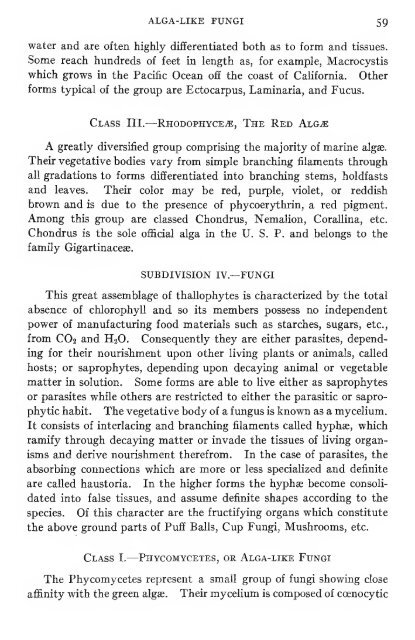Pharmaceutical botany - Lighthouse Survival Blog
Pharmaceutical botany - Lighthouse Survival Blog
Pharmaceutical botany - Lighthouse Survival Blog
You also want an ePaper? Increase the reach of your titles
YUMPU automatically turns print PDFs into web optimized ePapers that Google loves.
ALGA-LIKE FUNGI 59<br />
water and are often highly differentiated both as to form and tissues.<br />
Some reach hundreds of feet in length as, for example, Macrocystis<br />
which grows in the Pacific Ocean off the coast of California. Other<br />
forms typical of the group are Ectocarpus, Laminaria, and Fucus.<br />
Class III. Rhodophyce^, The Red Alg^<br />
A greatly diversified group comprising the majority of marine algae.<br />
Their vegetative bodies vary from simple branching filaments through<br />
all gradations to forms differentiated into branching stems, holdfasts<br />
and leaves. Their color may be red, purple, violet, or reddish<br />
brown and is due to the presence of phycoerythrin, a red pigment.<br />
Among this group are classed Chondrus, Nemalion, Corallina, etc.<br />
Chondrus is the sole official alga in the U. S. P. and belongs to the<br />
family Gigartinacese.<br />
SUBDIVISION IV.—FUNGI<br />
This great assemblage of thallophytes is characterized by the total<br />
absence of chlorophyll and so its members possess no independent<br />
power of manufacturing food materials such as starches, sugars, etc.,<br />
from CO2 and H2O. Consequently they are either parasites, depend-<br />
ing for their nourishment upon other living plants or animals, called<br />
hosts; or saprophytes, depending upon decaying animal or vegetable<br />
matter in solution. Some forms are able to live either as saprophytes<br />
or parasites while others are restricted to either the parasitic or sapro-<br />
phytic habit. The vegetative body of a fungus is known as a mycelium.<br />
It consists of interlacing and branching filaments called hyphae, which<br />
ramify through decaying matter or invade the tissues of living organ-<br />
isms and derive nourishment therefrom. In the case of parasites, the<br />
absorbing connections which are more or less specialized and definite<br />
are called haustoria. In the higher forms the hyphae become consoli-<br />
dated into false tissues, and assume definite shapes according to the<br />
species. Of this character are the fructifying organs which constitute<br />
the above ground parts of Puff Balls, Cup Fungi, Mushrooms, etc.<br />
Class I. Phycomycetes, or Alga-like Fungi<br />
The Phycomycetes represent a small group of fungi showing close<br />
affinity with the green algae. Their mycelium is composed of coenocytic
















